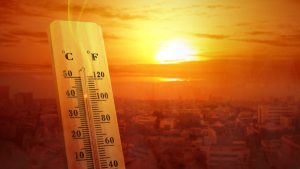
Late last year, the ABC published an article about the dangers of extreme heat – Australia’s silent killer. It’s an important read because extreme temperatures are becoming more common and, thanks to the already locked-in levels of climate change, will soon be “normal”. What can we do about it? Not much (although reducing emissions as fast as possible will help)…so we need to be prepared.
Extreme heat can be a killer. It especially affects already vulnerable groups, such as the elderly and infants, by putting strain on the heart, brain, and other internal organs. It causes dehydration and muscle cramps. It affects cognition, causes headaches, brain fog and sleep deprivation. Long term exposure can cause chronic illness.
Sadly, human-induced climate change has already affected the atmosphere and our weather systems so that even if we stopped using fossil fuels today, we would still experience most of the bad effects (extreme temperatures, heatwaves, drought, flood) for decades to come. We need to prepare ourselves and build resilient communities to enable us to adapt to these new prevailing conditions.
If you are a business owner, you have a duty of care towards your employees and your customers. You don’t want to create a legal risk from negligence. Be sure to adhere to the following basic steps:
- Provide air-conditioning and a fan where it’s appropriate.
- Be sure to check in with your employees regularly. Are they having adequate rest breaks and drinking enough water?
- Implement an extreme heat policy or include a heat clause in your workplace agreements.
Speaking with your employees to find out how you can help make them more comfortable at work shows that you value them and can help foster a positive workplace culture.
Part of corporate responsibility towards employees and customers in the current climate emergency is demonstrating a commitment towards climate action. Actively working towards carbon neutrality will prove your sincerity, enhance your corporate reputation, and help reduce emissions. Certifications such as Climate Active are great way to demonstrate this commitment and provide a benchmark so that you can document your success. If you don’t have the capacity to engage in this process yourself, we can help you.
Unfortunately, there is no avoiding the increase in frequency of extreme weather events, including heatwaves, but we can prepare ourselves by knowing the best ways to stay cool, and remember to check in on your friends and family and vulnerable neighbours. Most importantly, get to work reducing your carbon emissions so that we can limit the global temperature increase to 1.5°C above pre-industrial levels. This won’t fix the current problem, but hopefully it can prevent it getting much worse.
How to deal with extreme heat on an individual level:
- It might sound obvious but try not to move around too much.
- Find a cool community building. Go to the cinema, library, or the shopping centre.
- If you are at home, set the air-conditioner to 27ºC and then use a fan to keep the air circulating. This might seem quite warm but when compared to the temperature outdoors (which can regularly get up to the mid-40s in Adelaide summers), 27ºC will still feel like a cool change but will keep your energy costs down. What is important is to keep the air circulating, as without significant airflow, the body can’t evaporate sweat which is what keeps us cool.
- Wearing lighter clothing can make a significant difference. Light breathable fabrics like cotton will not trap heat close to the body.
- Be sure to drink water regularly. You will need to drink a lot more water to replace what you have been sweating out, but don’t overdo it. It is possible to drink too much water which can dilute the necessary tissue salts in our bodies causing muscle cramps. Try to keep your pee champagne coloured, if it looks like apple juice, you’re dehydrated.
